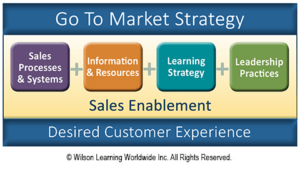Why Does Sales Enablement Matter?
Everyone wants “a piece” of the salesforce. Internal functions—such as marketing, training, research and development, and sales operations—all have information they want to get out to sales. Well-intentioned efforts to help equip your salespeople with knowledge, information, and resources may actually be wasting precious selling time as your salesforce struggles to make sense of it all. Let’s look at some of the symptoms that might indicate opportunities for improving your company’s efforts at sales enablement.
- Have your internal processes failed to keep pace with the way your customers prefer to shop, buy, and use your company’s products or services?
- Are you hearing customers and salespeople complain about information overload?
- Are various internal functions competing for your salespeople’s time?
- Are your salespeople receiving conflicting messages from different sources?
- Is time being wasted in training that is not relevant to the learner?
A Better Way—Sales Enablement
Put simply, sales enablement is an approach that bridges the gap between the sales strategy and execution. It helps organizations provide their salesforce with all the information and resources they need to generate revenue. And it ensures that every action you take aligns with the overall strategy of your organization and with the way you want your customers to experience your brand.
For example, one organization who adopted a sales enablement strategy was able to increase sales productivity by 15%. They achieved this by reducing time out of the field, increasing available selling time, reducing travel costs, and providing enhanced technology that made it easier for sales representatives to find and share resources based on individual buyer needs.
What Sales Enablement Isn’t
Sales enablement is a new term and many companies make the mistake of applying the new term to old ways of doing things. They rename “sales training” to “sales enablement” or they decide to create more mobile or other technology-assisted selling tools and call these sales enablement. The reality is that learning and technology are important to sales enablement, but they are only parts of the equation, and focusing on any one element in a vacuum is likely to produce limited results.
What’s Critical for Success?

A systems view of sales enablement includes four core elements that must be aligned with one another, your organization’s go-to-market strategy, and your vision for the desired customer experience. Achieving or improving this triple alignment of the four core elements, strategy, and customer experience is the ultimate objective of sales enablement.
Let’s consider each of the four elements that make up our sales enablement model.
Process Mesh or Mess?

All too often the sales processes and systems that are intended to help drive results actually end up conflicting with one another and consuming time. Consider the following questions:
- Does your salesforce rely on, or avoid, your CRM system?
- Do you have a consistent, defined sales process? Do your people use it?
- Even if your sales processes and systems satisfy the internal requirements of your sales organization, how well do they mesh with your customers’ shopping and purchasing processes?
- Do you fully understand the dependencies in the way these processes interact?
A sales enablement audit can identify inefficiencies and point the way to improvements that shorten the time it takes for prospects to become customers.


